Installation
Installation is a two-stage process. First you will need to download and install the application and then download and install the library.
1. Installing the application
To install the application you need to download the latest installation package. It comes as a Zip archive.
You need to extract files from this archive and run PTR_PPC_Setup.exe. Please note that in order to install successfully, you need to be logged on as Administrator of your PC.
Now you need to install the Pali font on your PocketPC. You should extract 3 files from fonts.zip archive and copy them to windows\fonts directory on the PocketPC.
2. Installing the pali text library
Just download the istallation package and run it on the PC. You can choose to install the library on your storage card.
After all the nessessary components are installed, you must soft-reset your pocketPC.
Usage
Running and exiting the application
To run the application just tap on the "Pali Text Reader" icon in
Programs. To close it tap Tools - Exit in the main menu.
The first start of the application is slow. That is by design.
 |
Main
application window
As of version 3.0 main window has a new look. Now there is only one
menu and frequently-used commands have their own toolbar buttons. |
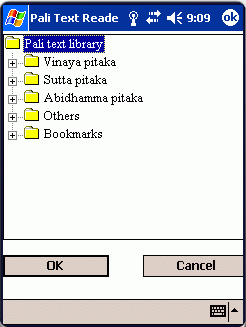 |
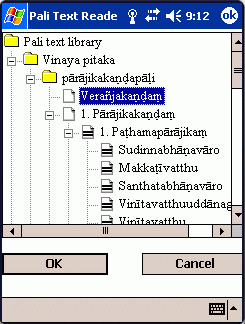 |
Opening a text for reading
Tap on "book" toolbar button
OR tap tools - "open book"
menu item. This will invoke
a dialog window that displays
all the books in the Pali Text
Library. You can expand tree
nodes like you do this in windows
explorer. You can only open
items marked with a "document"
icon (chapters and named paragraphs
within the books). Tap on the
item you want to open and tap
OK button below the tree. |
 |
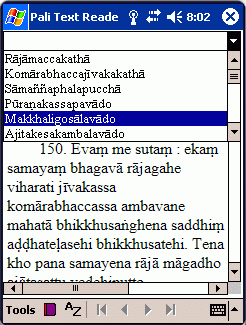 |
Reading the pali text
After clicking OK in the "open book"
dialog, the program will display
the text. The rendering can
take some time for large chapters.
You can scroll pages up and
down and you can use a navigation
dropdown list right above the
text. If the document you opened
contains named paragraphs (suttas
etc.), you can quickly jump
to them by selecting their names
in the list. |
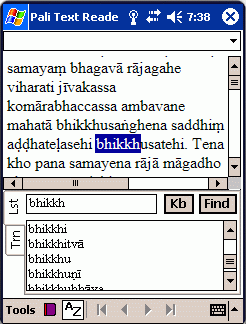 |
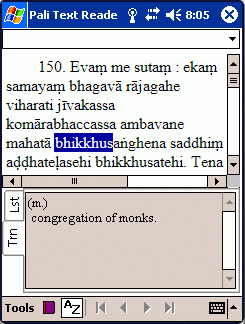 |
Using the dictionary
To look up a word in the dictionary you need to select it with stylus.
Then tap on the selection and choose "Translate term". If
an exact match is found in the dictionary, it will show you
the translation. If there are several matches, it will show
you a list of matches. You can tap on the word in this list
to see its translation. The active mode (list or translation)
can be switched by tapping on tabs on the left side.
You can also type the search word with
on-screen keyboard and click
"Find" to look it
up in the dictionary. To enter
Pali special characters tap
on the Kb button. This will
invoke a dialog window that
makes possible to enter them.
You can show or hide the dictionary
window anytime by using the
"Az" (dictionary)
toolbar button OR tap tools
- "Toggle dictionary"
menu item.
The first term lookup is slow. That
is by design.
|
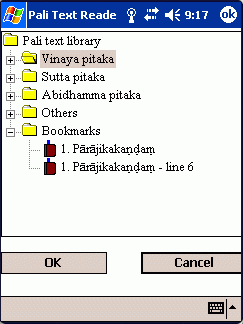 |
Using the bookmarks
Bookmarks are useful for accessing the texts you read often. You
can bookmark any chapter or paragraph in the "open book"
dialog by tapping and holding on it and clicking "bookmark
this item" in the context menu. The new bookmark is added
to "bookmarks" collection under the "pali text
library" tree node.
To open the bookmarked text select
its bookmark and tap OK button.
To rename a bookmark tap and hold on it and select "rename"
from the context menu. Enter a new name for the bookmark with
on-screen keyboard and tap anywhere on the screen outside
the editing area to complete.
To delete a bookmark that is no longer needed tap and hold on it
and select "delete" from the context menu.
You can bookmark a page while you are
reading the text. To do this
tap tools - "bookmark this
page" in the program's
Tools menu. A new bookmark will
be created and added to the
bookmarks list.
|
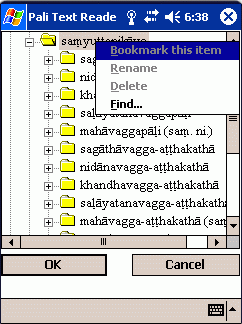 |
Searching for a sutta (vagga etc)
- Tap-and-hold on the container
node you want to search
within (this may be
a Pitaka or any child
node below it). The
context menu appears.
- Tap Find.
- Enter the name of the sutta
(vagga etc) and tap
OK.
The first found document
will be selected in
the tree.
Note 1: There is no "Find next"
option. It will find the first
match only. Any part of the
sutta name will match.
Note 2: The search may take
some time to complete if you
start it within a container
that holds many child nodes
(e.g. whole Sutta Pitaka).
Note 3: The search is performed
within names only, NOT the sutta
content!
|
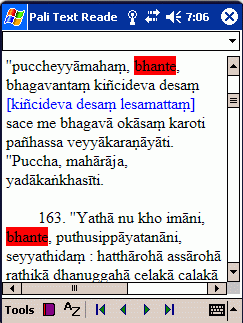 |
Searching within the currently open
document
To search text within the open document
you should follow the steps
below:
- Tap tools-"search
in this text"
menu item.
- Enter the word/phrase to
search for. It is
possible to enter
Pali special characters.
- Tap OK.
The document is reloaded
and all the found matches are marked with
red background. You can click First-Prev-Next-Last
green toolbar buttons to navigate between
search results. |
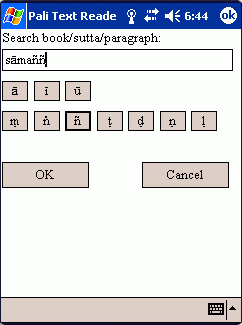 |
Entering pali text
This dialog is used to enter pali text
and is invoked from the dictionary
window. All the search facilities
invoke it as well. |
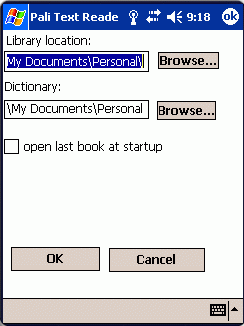 |
Preferences dialog
The preferences dialog can be opened
by clicking File - Preferences
in the main menu. There are
three program settings.
1. Library location. This is
a directory where pali text
library resides.
2. Dictionary. This is the full
file name of the dictionary.
3. open last book at startup.
Check this if you want the last
book you opened to be opened
automatically each time you
start the program. The page
is remembered as well. |
About the author
Pali Text Reader for PocketPC is written in Embedded Visual C++ 4.0 by PavelBure (that's my nickname), a programmer from Moscow, Russia
It is distributed under the same terms as desktop PC version with full source code available.











